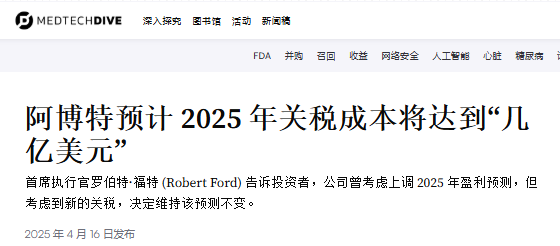Abbott May Lose $2.2 Billion This Year, with Major Pressure in U.S. and China Markets
01
Abbott CEO:
Yesterday (April 16, 2025), global medical device giant Abbott revealed in a earnings call that the company expects the tariff policies this year to impact the company by “hundreds of millions of dollars.”

Although Abbott did not provide a breakdown of the tariff costs, according to Vijay Kumar, an analyst at the well-known global investment bank Evercore ISI, it is estimated that tariffs will have a negative impact of approximately $300 million (equivalent to about 2.2 billion yuan) on Abbott this year.
Among them, the U.S. and Chinese markets will be the main pressure points. Reuters reported that China is the primary source of raw materials for the pharmaceutical and medical device industries.
It is worth noting that just one day before Abbott disclosed this information, a senior executive at Johnson & Johnson also publicly stated that the increase in global tariffs would exacerbate the company's financial losses by $400 million (approximately 3 billion RMB), with 70% of the tariff costs stemming from medical device exports to China.
02
"Tackle challenges with a two-pronged approach"
Faced with this situation, Abbott has initiated a short-term contingency plan and is leveraging its global network of 90 production bases to seek buffer space.
Abbott also announced an investment of $500 million (approximately RMB 3.65 billion) in manufacturing and research projects in Illinois and Texas to produce equipment for screening blood and plasma donations.
These projects are expected to be operational by the end of this year and will help Abbott mitigate the potential impact of the high tariffs imposed by President Donald Trump on China.
Abbott CEO Robert Ford emphasized in the meeting that the company has established a "distributed production network" to mitigate risks through global supply chain optimization. Although Abbott is actively lobbying alongside the medical device industry association AdvaMed, he admitted to having "low expectations" for obtaining tariff exemptions. Citing the China tariff policies during Trump's first term, he noted, "Historical experience shows that once tariffs are imposed, they are difficult to roll back."
Financial report data show that, excluding the impact of exchange rate fluctuations and the decline in COVID-19 testing business, Abbott's global sales in the first quarter of 2025 increased by 8.3% year-on-year to 10.36 billion US dollars.
The company reiterated its full-year financial targets: revenue growth of 7.5%-8.5%, and adjusted earnings per share of $5.05-$5.25.
Ford stated, "Before the tariffs were implemented, we had considered raising our earnings forecast. However, under the current circumstances, maintaining the original guidance already reflects the company's confidence."
On that day, Abbott's stock price rose by 6% in early trading.

Abbott's response strategy this time is a portrayal of how multinational medical device companies adapt to the squeeze between the waves of globalization and localized demands.
As the China-U.S. trade friction continues, multinational companies are seeking a balance between political risks and market efficiency through measures such as regionalized production capacity layout and diversified supply chain construction.
【Copyright and Disclaimer】The above information is collected and organized by PlastMatch. The copyright belongs to the original author. This article is reprinted for the purpose of providing more information, and it does not imply that PlastMatch endorses the views expressed in the article or guarantees its accuracy. If there are any errors in the source attribution or if your legitimate rights have been infringed, please contact us, and we will promptly correct or remove the content. If other media, websites, or individuals use the aforementioned content, they must clearly indicate the original source and origin of the work and assume legal responsibility on their own.
Most Popular
-

Dow, Wanhua, Huntsman Intensively Raise Prices! Who Controls the Global MDI Prices?
-

Clariant Unveils Cost-Cutting Plan Details, Plans to Shut Down Multiple Plants
-

[Today's Plastics Market] General Materials Weakly Fluctuate, Engineering Materials Steadily Rise
-

New Breakthrough in Domestic Adiponitrile! Observing the Rise of China's Nylon Industry Chain from Tianchen Qixiang's Production
-

Daily Review: Polyethylene Prices Under Weak Consolidation, Sellers Face Significant Pressure to Move Inventory






